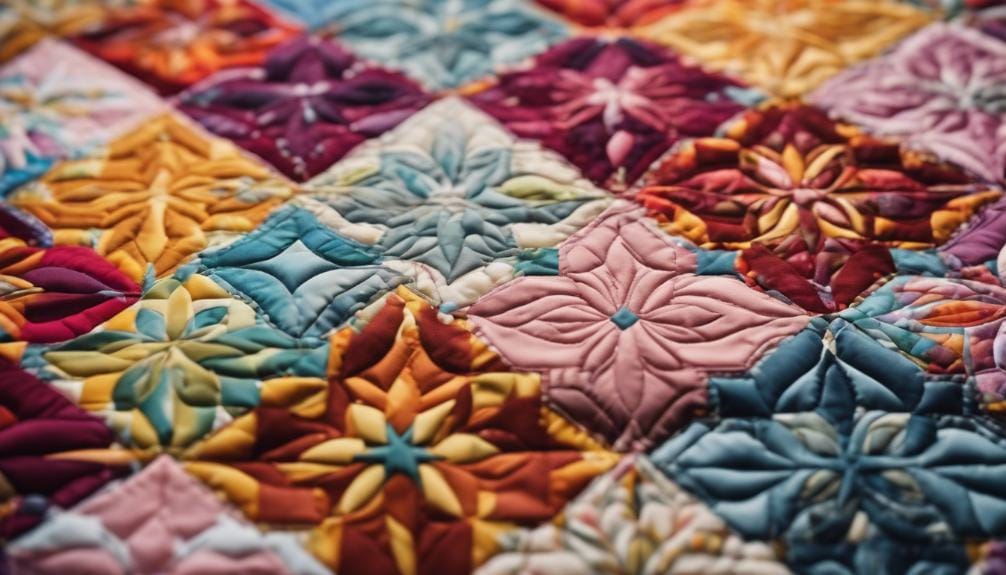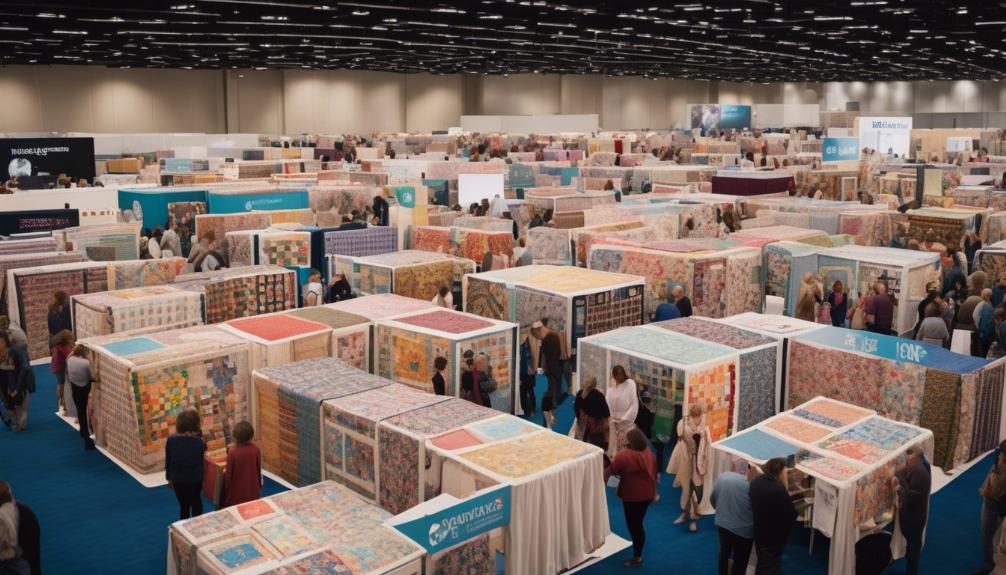What Is Quilt Market: Industry Insights & Trends
Imagine entering a bustling hall filled with vibrant colors and intricate patterns adorning every corner. At Quilt Market, you are immersed in a world where creativity meets commerce, where the latest trends in quilting and textiles converge.
Discover how this event shapes the industry’s landscape, influences design choices, and sets the stage for future innovations. Uncover the secrets behind what makes Quilt Market an essential destination for those in the know, where connections are made, and opportunities abound.
Key Takeaways
- Quilt Market is a wholesale trade show for quilting industry professionals.
- It showcases the latest trends, innovations, and designs in quilting.
- Provides networking opportunities, professional growth, and valuable industry insights.
- Essential platform for connecting with designers, retailers, and exploring new products.
Origins of Quilt Market
Quilt Market, established in 1979 by Houston quilt shop owner Karey Bresenhan, traces its origins to the vision of a passionate industry professional. Karey Bresenhan, the founder and president of Quilts, Inc., recognized the need for a dedicated platform where industry professionals could come together to showcase their products and services. This vision led to the creation of Quilt Market, a wholesale trade show that has since become a cornerstone event in the quilting and soft crafts industry.
The roots of Quilt Market can be traced back to Bresenhan’s deep understanding of the quilting world and her desire to provide a space for industry professionals to connect, collaborate, and thrive. As a Houston quilt shop owner, Bresenhan recognized the potential for a trade show that would cater specifically to the needs of those in the quilting industry. Thus, Quilt Market was born, offering a unique opportunity for exhibitors to display their products to a targeted audience of buyers and industry insiders.
Since its inception, Quilt Market has grown significantly, with approximately 600 exhibitors and 2,000 booths at each market. The event’s success can be attributed to Bresenhan’s foresight and dedication to creating a space where industry professionals can come together to explore the latest trends, products, and innovations in the world of quilting.
Evolution of Quilting Trends

The changing landscape of the quilting industry is evident in the dynamic shift from traditional patterns to cutting-edge, innovative designs that push the boundaries of creativity and craftsmanship. Quilting trends have evolved significantly over the years, with quilters now embracing modern designs, influenced by technological advancements and a desire to break away from traditional norms. Experimentation with different textures, colors, and techniques has become a common practice among quilters, leading to the creation of unique and artistic quilts.
To showcase the evolution of quilting trends, collaborations between quilters and designers have become more prevalent. This partnership has sparked new ideas and brought fresh perspectives to the quilting world, contributing to the rise of innovative designs that captivate audiences globally.
Moreover, social media platforms have played a pivotal role in shaping contemporary quilting trends. Through platforms like Instagram, Pinterest, and Facebook, quilters can share their work, connect with other enthusiasts, and draw inspiration from a vast online community. The instant feedback and visibility provided by social media have propelled the popularity of modern quilting designs, influencing the direction of the industry and strengthening customer relations.
| Trending Aspects | Description | Influence |
|---|---|---|
| Modern Designs | Embracing innovation and creativity | Pushing the boundaries of traditional quilting |
| Technological Advancements | Incorporating digital tools for design | Influencing the creation of intricate patterns |
| Social Media Presence | Showcasing work and connecting with a global audience | Inspiring and influencing quilting trends |
Impact on Industry Professionals

Exploring the impact of Quilt Market on industry professionals reveals a platform that fosters networking, business relationships, and product exploration within the quilting and soft craft community. Attendees, including teachers, designers, publishers, and retailers, benefit from firsthand knowledge about inventory planning and new techniques. The event, hosting approximately 600 exhibitors with 2,000 booths, showcases a wide array of quilting and soft craft products, offering professionals a comprehensive view of the market landscape.
For shop owners, Quilt Market provides valuable opportunities for professional development. The Schoolhouse sessions offer insights into new products, ideas for in-shop classes, and strategies for enhancing their businesses. These sessions equip shop owners with the knowledge and tools necessary to stay competitive in the industry and meet the evolving needs of their customers.
Additionally, the Sample Spree event, held before the main show, enables fabric stores to get a head start on purchasing new fabrics and patterns. This early access allows shop owners to create samples and stock their stores with the latest products, giving them a competitive edge in meeting consumer demands. Overall, Quilt Market plays a pivotal role in advancing the skills and businesses of industry professionals, making it a must-attend event for those in the quilting and soft craft community.
Latest Innovations and Designs

Amidst a sea of vibrant displays and bustling booths, attendees at Quilt Market immerse themselves in the latest innovations and designs shaping the quilting industry. This event serves as a hub for creativity and inspiration, showcasing cutting-edge ideas and trends that push the boundaries of traditional quilting.
- International Exhibitors: Quilt Market brings together a diverse range of exhibitors from around the globe, offering attendees a unique opportunity to explore different cultural influences and design perspectives. The presence of international exhibitors adds a rich tapestry of creativity to the event, providing a global outlook on the quilting industry.
- New Product Launches: Market attendees eagerly anticipate the unveiling of new products, eagerly seeking out the latest trends and techniques in the quilting world. From innovative fabrics to state-of-the-art sewing machines, these launches set the stage for the future of quilting, inspiring enthusiasts to experiment and create with fresh tools and materials.
- Creative Designs: Designers use Quilt Market as a platform to introduce their most imaginative and artistic creations to a captivated audience. Attendees have the opportunity to witness firsthand the most creative designs in the industry, sparking their own creativity and fueling their passion for quilting.
Networking Opportunities

Attendees at Quilt Market have abundant opportunities to connect with industry professionals, designers, retailers, and manufacturers, fostering valuable relationships that can open doors to collaborations and new prospects. Networking at Quilt Market is a vital component of this wholesale trade show, providing a platform for individuals to engage with key players in the industry and stay abreast of the latest industry trends. Through these interactions, attendees can gain insights into innovations, best practices, and emerging market demands, ultimately enhancing their business acumen and competitive edge.
| Benefits of Networking at Quilt Market | Description |
|---|---|
| Establish valuable relationships | Connect with industry professionals and explore collaboration opportunities. |
| Stay updated on industry trends | Engage in conversations that offer insights into the latest market trends and innovations. |
| Discover new products and resources | Network with designers, retailers, and manufacturers to uncover new products and suppliers. |
Networking at Quilt Market goes beyond simple introductions; it is a strategic opportunity to position oneself within the industry, forge meaningful connections, and contribute to the vibrant community that defines the quilting and textile sectors. By actively participating in networking activities, attendees can expand their professional network, gain valuable industry insights, and pave the way for future growth and success.
Frequently Asked Questions
Can Anyone Go to Houston Quilt Market?
Yes, anyone can go to Houston Quilt Market if they are an industry professional or buyer. Proof of industry-related designs and business documentation is required for entry. Remember, children under 14 are not permitted on the trade show floor.
How Big Is the Quilt Market?
Quilt Market is massive, featuring around 600 exhibitors with 2,000 booths. It offers 250 classes at Schoolhouse sessions. Sample Spree, a pre-show event, is key for retailers to purchase new fabrics. Utilize it to prep shop samples.
What Is Quilt Business?
In the quilt business, you manage the creation, sale, and distribution of quilting products. This industry encompasses designing patterns, sourcing materials, marketing, and selling finished quilts or supplies. Building a brand and loyal customer base is crucial.
What Is the Purpose of Quilt?
The purpose of a quilt is to provide warmth, comfort, and decoration. Quilts are made by sewing layers of fabric together, creating a cozy and artistic piece that can be used for bedding or as a decorative throw.
Conclusion
In conclusion, Quilt Market serves as a vital platform for industry professionals to stay updated on the latest trends, innovations, and designs in the quilting and textile industries.
With a rich history dating back to 1979, this trade show offers valuable networking opportunities and educational seminars for shop owners and experts alike.
Attendees can explore a wide range of products and gain insights into the ever-evolving world of quilting, making it a must-visit event for those in the industry.
